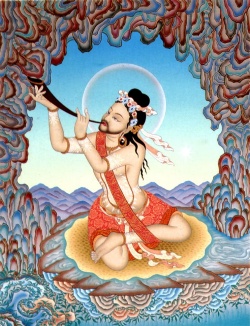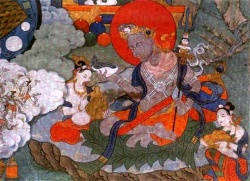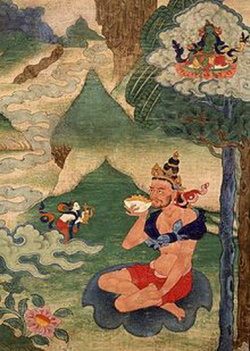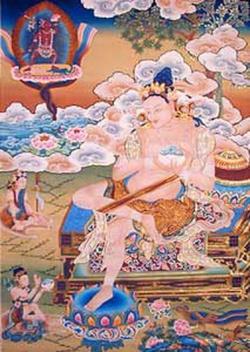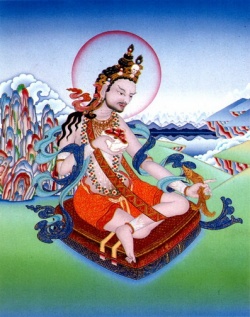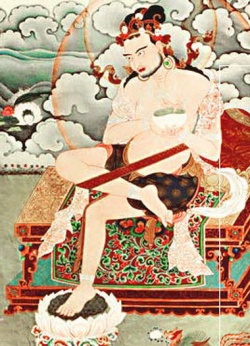Six Yogas of Naropa
[[File:Naropa.png|thumb|Naropa)] The Six Yogas (or, more literally, Dharmas of Naropa (ན་རོ་ཆོས་དྲུག་, Wyl. na ro chos drug), sometimes also referred to simply as the Six Yogas (ཆོས་དྲུག་, Wyl. chos drug), are six sets of teachings and practices which originate from the Indian mahasiddha Naropa.
They form the basis of the inner yoga practices of Mahamudra, as practised in the Kagyü and Gelug schools.
They are:
For a dzogrim practitioner this meditation on inner heat is like the root of the entire path.
Without some experience of tummo practice, it is said, the various experiences (Tib. ཉམས་, nyam) of tsa-lung practice such as bliss, clarity and absence of thought will not arise.
- Illusory body (Tib. སྒྱུ་ལུས་, gyu lü; Wyl. sgyu lus) which is the foundation of the path.
- Clear light/luminosity (Tib. འོད་གསལ་, ösal; Wyl. 'od gsal) which is the heart-essence of the path.
- Then in order to test the strength of, or assess one's progress in, the practice of clear light, there is the dream yoga (རྨི་ལམ་, Wyl. rmi lam).
- For those who are unable to complete the practice of clear light because untimely death occurs, there needs to be one who picks them up, just as when one is travelling to a country such as France and one needs to be picked up at the airport.
The practice which comes to 'collect' you is the practice of phowa (འཕོ་བ་, Wyl. 'pho ba).
- Then, finally, the juncture which bridges the gap between past and future lives and provides a connection with the Zangdokpalri heaven of Guru Rinpoche or the pure realms such as Sukhavati (Tib. བདེ་བ་ཅན་, Dewachen), is the bardo.
By applying the bardo teachings a practitioner whose practice isn't particularly great can transform their practice and become a great practitioner.
Further Reading
- Garma C.C. Chang, The Six Yogas of Naropa, Snow Lion, 1986
Source
The Six Yogas of Nāropa (Tib. Narö chö druk, na-ro'i-chos-drug), also called the six dharmas of Naropa.
Naro's six doctrines (Mandarin: Ming Xing Dao Liu Cheng Jiu Fa; rendered in English as:
Wisdom Activities Path Six Methods of Accomplishment), are a set of advanced Indo-Tibetan Buddhist tantric practices and a meditation sādhana compiled in and around the time of the Indian monk and mystic Nāropa (1016-1100 CE) and conveyed to his student Marpa the translator.
The six yogas were intended in part to help in the attainment of siddhi and enlightenment in an accelerated manner.
Six Yogas or Six Dharmas?
Peter Alan Roberts notes that the proper terminology is "six Dharmas of Nāropa", not "six yogas of Nāropa":
- "Tilopa briefly described these six practices in a short verse text entitled Instructions on the Six Dharmas.
In Tibet these practices became known as the six Dharmas of Nāropa.
In English they became known as the six yogas of Nāropa through their being first translated in 1935 by Evans-Wentz in Tibetan Yoga and Secret Doctrines, even though Evans-Wentz only referred to them as "six doctrines," which is the equivalent of six Dharmas.
The term yoga (sbyor ba) is never used for this set of practices in Tibetan, and they should not be confused with the Kālacaka tradition's group of six practices that are called yogas."
Classification
The six Dharmas are a synthesis or collection of the completion stage practices of several tantras.
In the Kagyu traditions by which the six Dharmas were first brought to Tibet, abhiṣeka into at least one anuttarayoga tantra system (generally Cakrasaṃvara and/or Vajrayogini/Vajravarāhi) and practice of its utpatti-krama are the bases for practice of the six Dharmas;
there is no particular empowerment for the six Dharmas themselves.
The six yogas
Though variously classified in up to ten yogas, the six yogas generally conform to the following conceptual list:
(Tibetan Wylie transliteration and Sanskrit in parentheses)
- tummo (T: གཏུམ་མོ་ gtum-mo, S: caṇḍālī) — the yoga of inner heat (or yoga of mystic heat).
- gyulü (T: སྒྱུ་ལུས sgyu-lus, S: māyākāyā) — the yoga of the illusory body.
- ösel (T: འོད་གསལ་ 'od-gsal, S: prabhāsvara) — the yoga of the clear light or radiant light.
These next three are considered the main practices of the completion stage (T: dzog-rim, S: saṃpanna-krama) in the anuttara yoga tantra.
- milam (T: རྨི་ལམ་ rmi-lam, S: svapnadarśana) — the yoga of the dream state.
- bardo (T: བར་དོ bar-do, S: antarābhava) — the yoga of the intermediate state.
This is well-known through the Bardo Thödöl.
Bardo yoga as the yoga of liminality may include aspects of gyulu and milam and is therefore to be engaged as an extension of these disciplines.
- phowa (T: འཕོ་བ་ 'pho-ba, S: saṃkrānti) — the yoga of the transference of consciousness to a pure Buddhafield.
Alternate formulations
Other yogas, sometimes grouped with those above, or set as auxiliary practices, include:
- Drongjuk Phowa - Keown, et al. (2003) list a "seventh yoga" that is a variation of phowa, in which the sādhaka by transference (grong-'jug), may transfer their mindstream into a recently deceased body.
This technique may no longer be extant, or is kept secret.
The forceful projection of the mindstream into the body-mind of another is a variation that consists of elements of phowa, ösel and gyulu.
- Karmamudrā or "action seal" (T: las-kyi phyag-rgya) (erroneously: kāmamudrā or "desire seal") .
This is the tantric yoga involving sexual union with a physical partner, either real or visualized.
Like all other yogas, it cannot be practiced without the basis of the inner heat yoga, of which karmamudrā is an extension.
- Self-liberation - Nāropa himself, in the Vajra Verses of the Whispered Tradition, adds the practice of self-liberation in the "wisdom of non-duality" which is the resolved view of mahāmudrā and dzogchen.
But this is always considered as a distinct path.
- Yantra - There are many practices and physical exercises called yantras, preliminary to the inner heat yoga.
A good example of this is the visualization on the body as being hollow: "here the body and the energy channels (nadis) are to be seen as completely transparent and radiant".
This essential technique releases tensions and gives suppleness to the prāna channels.
As Nāropa is regarded as a Kagyu lineage holder, the six meditative practices are strongly associated with the Kagyu lineage of Tibetan Buddhism.
The teachings of Tilopa (988-1069 CE) are the earliest known work on the six yogas.
Tilopa is said to have received the teachings directly from Cakrasaṃvara.
Nāropa learned the techniques from Tilopa.
Nāropa's student Marpa taught the Tibetan Milarepa, renowned for his yogic skills.
Milarepa in turn taught Gampopa.
Gampopa's student, the future first Karmapa, Düsum Khyenpa, attained enlightenment while practicing the six yogas.
The Karmapa, the first figure in Tibetan Buddhism whose reincarnation was officially recognized, has been strongly associated in certain reincarnations with particular yogic attributes.
Many Gelugpa practitioners including Dalai Lamas are expert in the six yogas of Nāropa.
The six yogas of Naropa are ordered and progressive, each subsequent yoga building on previous attainments.
Physical exercises
Before engaging in the actual yogas, one begins by doing the "six exercises of Naropa".
Trülkhor (Tibetan 'khrul-'khor)
- Hooking like a Hook — snapping the elbow into the chest
- Showing the Mudrā of Vajra Binding — moving the mudrā from the crown downwards
- Straightening like an Arrow — hands and knees on the floor with the spine straight; heaving like a dog
- Shaking the Head and Entire Body — pulling the fingers, followed by massaging the two hands
Meditation on the body as an empty shell
Here the body is envisioned as being entirely without substance, appearing in the mind like a rainbow in the sky.
This meditation and the physical exercises should be practiced in conjunction with one another.
Stages of meditating upon the actual path
Inner heat
(Tib. gtum-mo) Visualizing the channels, Visualizing the mantric syllables and engaging in the vase breathing technique.
This gives rise to five signs: like a mirage, like a wisp of smoke, like the flickering of fireflies, like a glowing butter lamp, and like a sky free of clouds.
Four blisses
(Tib. dga'-ba bzhi) Bliss at the throat chakra,
supreme bliss at the heart chakra,
inexpressible bliss or special bliss at the navel chakra, and
innate bliss at the secret place, tip of the jewel.
This is accomplished by relying on two conditions; the internal condition of meditating on inner heat yoga and the external condition of relying upon a karmamudrā.
The four types of Karmamudrās
- Karma Mudrā A maiden possessing the physical attributes of a woman, for dull yogis.
- Jñāna Mudrā A maiden created through the power of one's visualization, for middling yogis.
- Mahā Mudrā The images within one's own mind spontaneously arise as various consorts, for sharp yogis.
- Samaya Mudrā The mudra experienced as a result of accomplishing the former three.
- These are usually termed the 'four handseals' with only the last one called mahamudra.
There are various lists, usually some combination of the following:
Phenomena Mudra (Dharmamudra),
Pledge Mudra (Samayamudra), and
Action mudra is a woman, phenomena mudra is all appearance, commitment or pledge mudra is tummo, wisdom mudra is the meditation deity, and non-duality is the great mudra.
Pure illusory body
(Tib. dag-pa’i sgyu-lus) Meditations on all appearances as illusory, dream illusions, and bardo experience.
Actual clear light
(Tib. don-gyi ‘od-gsal) The four emptinesses lead to the experience of clear light during the waking period and during sleep.
Emptiness, Very Empty, Great Emptiness, and Utter Emptiness
They are associated with external and internal signs of the appearance of mirage,
smoke,
fireflies,
cloudless sky;
and whiteness,
redness, blackness,
and the clear light of early dawn which resembles a mixture of sunlight and moonlight, respectively.
Union of clear light and illusory body
(Tib. zung-'jug) Actualizing the results.
The state of a Buddha Vajradhāra)]
Transference of consciousness and forceful projection (Tib. phowa grong 'jug)
The branches of that path.
There are two ways to practice the transference of consciousness: with a support and without a support.
Separating the body and the mind without a support is achieved through the emptiness of great conceptlessness whereby the mind is not attached to the body and the body is not attached to the mind.
Separating the body and the mind with a support, on the other hand, requires one to imagine the mind as a substance.
With awareness one draws the mind up the central channel and then with force expels the mind into the space of the sky.
There are two methods to separate a body and a mind with support: transference in stages, and transference all at once at the time of death.
Transference in stages involves dissolving the sufferings of the six realms into a bindu which ascends the body and travels upwards in the central channel.
Starting under the sole of the feet, each point radiates colored light.
Feet: black-hell, joining yellow-hungry-ghosts together at the secret place.
At the navel: gray-animals. At the heart: green-human.
At the throat: red-demigods, and at the crown: white-gods.
Once the bindu has reached the crown, it has the nature of five colors, corresponding to the last five stages (black is not counted).
This bindu then leaves the central channel through the crown and comes to rest inside the heart of a deity that is one cubit above in space.
The mind is rested in equipoise in this state.
Related traditions
The six yogas of Niguma are almost identical to the six yogas of Nāropa but are the version taught by Niguma who was both a teacher and, depending on the sources, either the sister or spiritual consort of Nāropa.
The second Dalai Lama, Gendun Gyatso has compiled a work on these yogas.
Niguma transmitted her teachings to yogini Sukhasiddhī and then to Khyungpu Neldjor, the founder of the Shangpa Kagyu lineage.
A translator and teacher in the lineage, Lama Sarah Harding, is currently working on a book about Niguma and the core role her teachings such as the six yogas of Niguma have played in the development of the Shangpa Kagyu lineage.
In the lineage of Machig Labdron, The practice of Mahamudra Chod begins with The Yoga of the Transference of Consciousness.
